Color Desaturates Close to a Light Source
Have you ever wondered if the colors of the objects you saw were true or not? Abstract philosophy aside, it isn't a question you need to worry about too much in natural sunlight. But for artificial light sources, such as LED light, it is worth it to look closely and think twice. Read further to understand how color is reproduced by artificial LED light sources.
What are the color rendering properties of artificial light sources?
Generally, we consider the colors of objects perceived under natural sunlight as the true and original colors of objects. In other words, natural sunlight could most faithfully reproduce the colors of objects. While it is a different story for artificial light sources, including LED light.
In specific artificial lighting environments, one object might be perceived as more "colorful" or "vibrant" than if in others, or even totally different in certain cases. This is because an object itself has no colors. When light shines onto an object, it absorbs and reflects a certain range of the waveforms from that light source. Depending on the specific waveforms reflected, the objects are perceived in different colors. Sunlight and incandescent light sources contain the full spectrum to be reflected. While for artificial light sources that are produced by mixing of limited primary colors, certain waveforms are missing and thus impossible to be reflected by the object. As a result, the colors of the object in this particular artificial light source can look different or "off".
How the original color of an object is faithfully reproduced by an artificial light source compared to that of a reference (natural) light source is referred to as the color rendering property of the artificial light source in question.
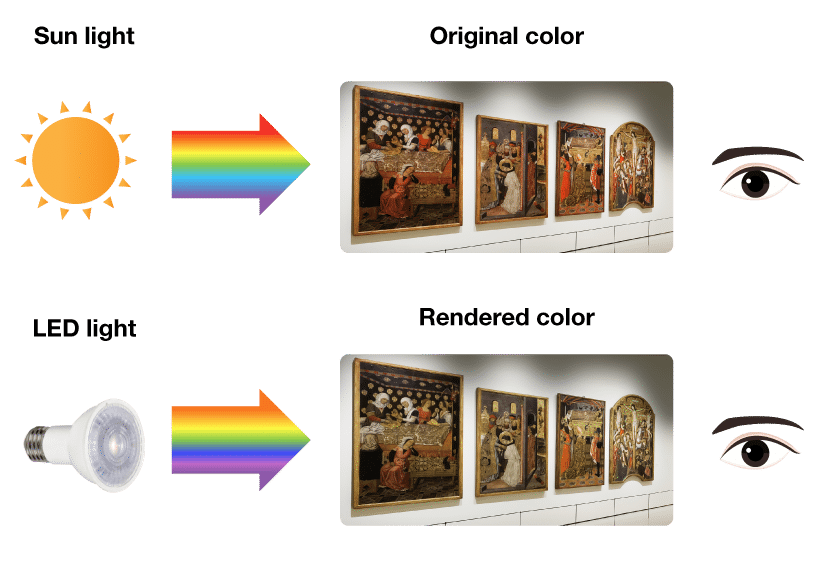
How is color rendering property measured?
The most historical and widely used metric to evaluate color rendition in the lighting industry is Color Rendering Index (CRI), developed by CIE. CRI is quantified by a scale up to 100. Full spectrum natural sunlight or traditional incandescent light sources have the highest CRI values of 100.
To measure the CRI value of an LED light, a series of 14 test color samples are used. The light source in question will be shone onto each of the test color samples. With the reflected color measured and compared to that of the reference light source in the same color temperature, we get the score called "Ri" for each color sample. Where R refers to rendering score, and i indicates the index number of that color sample. For example, R8 is the rendering score for color sample index number 8, which indicates its ability to faithfully reproduce the color of light 'reddish purple'.
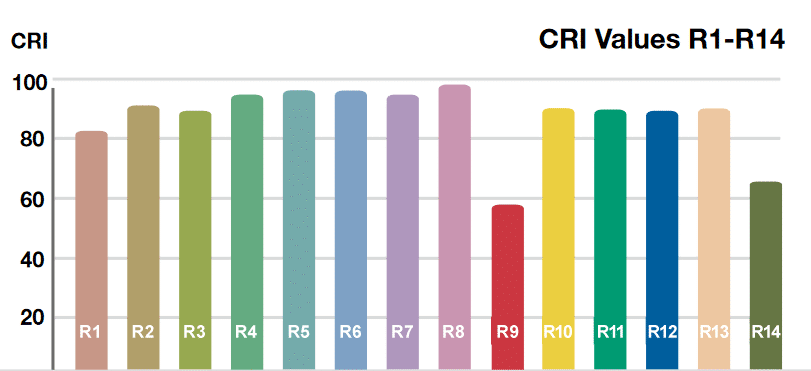
With each of the R values calculated, we could further calculate two types of metrics, which are General CRI (Ra) and Extended CRI. General CRI (Ra) is calculated as the average value of R1 through to R8, which is used as the standard indicator for color rendering ability according to the CIE CRI metrics. Extended CRI includes all the values from R1 through to R14, and is often used as supplementary indices by manufacturers for communicating the color rendering features for those colors not covered by R1-R8, among which R9 and R13 are the most frequently used since they refer to the color of red and skin tones.
Is CRI sufficient to indicate color rendition faithfully?
CIE CRI metric has been used for over 50 years in the lighting industry. For the traditional incandescent and halogen light sources, this metric is good enough due to the full spectrum nature of those light sources. While with the advance of technology and much more possibilities introduced by LED light, it has becomes common knowledge that CIE CRI is not a sufficient nor fair metric anymore in cases of LED light, because it covers only 8 color samples and also fails to consider saturation.
In 2015 a new method for measuring color rendering property was introduced to the industry by IES called TM-30-15. TM-30-15 is also a reference-based method and the reference illuminants used are the same as in the CIE CRI system. The difference is, instead of using only 8 color samples, TM-30-15 uses a cautiously selected set of 99 color samples for testing and presents a more comprehensive suite of numerical and graphical outputs including Rf (Fidelity index), Rg (Gamut index), and Color Vector Graphic.
Rf characterizes the average color shift of the 99 color samples. Values range from 0 to 100.
Rg characterizes the average saturation level among the defined 16 hues. A neutral score is 100. Values above 100 indicating oversaturation while values below 100 indicating desaturation. The range in values grow as fidelity decreases.
Color Vector Graphic is a visual representation which illustrates average hue and saturation changes in each of the16 hue bins. The graphic provides a quick understanding of how saturations or hues are rendered in different ways comparing to the measurements from the reference light source.
These outputs together will reflect not only whether each of the tested color samples will be faithfully reproduced or not, but also whether the low score, as a result, comes from a desaturation, oversaturation, a hue deviation, or any combination of the above. With these comprehensive outputs, specifiers or lighting designers could have a much more thorough understanding and accurate anticipation regarding how the colors of certain objects and applications will look under the LED light source in question.
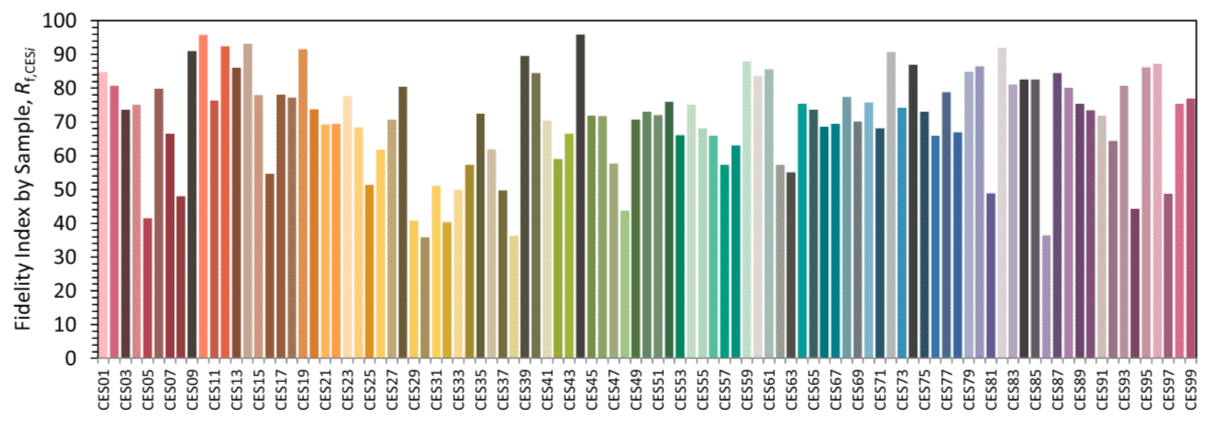
Rf is the average result of all values measured from the 99 color samples. Rf,CESi (i=1 to 99) is the measurement result of each specific color sample. Rf,skin ((Rf,CES15 and Rf, CES18) characterizes the similarity of skin tones.
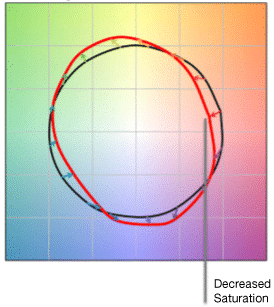
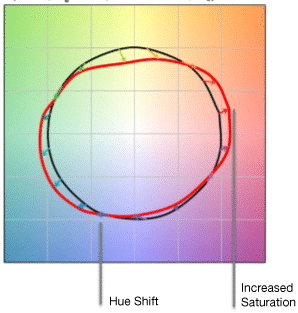
In the color vector graphics, the reference source is normalized to a black circle, whereas the test source is represented by the red line. Arrows show specific distortions: arrows pointing in from the black circle indicate a region of desaturation, arrows pointing out from the black circle indicate a region of increased saturation, and arrows tangential to the black circle indicate hue shift only.
For additional information on the TM-30-15 test method please visit: https://www.energy.gov/sites/prod/files/2015/12/f27/tm-30_fact-sheet.pdf
How to evaluate color rendition specification of LED light?
Most manufacturers now publish the general CRI (Ra) value in the specification sheets of their products. Generally, a CRI (Ra) of 60 and below is considered very poor while a CRI (Ra) of 80 and above is considered good. Halogen and Incandescent sources have CRI (Ra) close to 100, while fluorescent sources are usually below 85. For indoor LED lightings, both ENERGY STAR® and Designlights Consortium® (DLC) have the minimum requirement for CRI (Ra) of 80.
But as explained before, it is always more thoughtful to check also R9 and R13 values as supplementary indices if using CIE CRI metrics for covering more colors scopes. While for much more color cautious applications, values and graphics outputs per TM-30-15 method should include into consideration in order to get a more thorough and better anticipation of the overall color rendition result.
What are the applications where color matters more?

Using LED light with excellent color rendering ability is critical for certain applications, such as art galleries, retail and grocery stores, high-end hospitality environments, and clothing outlets etc. On the other hand, color rendering preferences might be different depending on the specific applications. For example, in hospital or nursery rooms, overall color fidelity is more important because we need to most faithfully re-produce the true colors of objects and people as they are. While for retail environments, a bit oversaturation as a tradeoff to overall color fidelity might be preferred since it can enhance the vividness of the merchandise colors and make them look more appealing for customers thus promoting better business results. In hospitality applications, such as hotel rooms, massive blue hues should be avoided in order to create a cozy and relaxing environment for guests. So, to answer the question of how to choose the light source with most suitable color rendering property, there is not a simple and single solution for all, and the unique needs of different specific applications should always be considered. It is even ideal whenever possible to prepare mock-ups and test the final result effects in actual scenes before final installation.
What is TRUE CHROMA
GREEN CREATIVE's products with TRUE CHROMA technology have the highest color accuracy standards per CRI and the new IES TM-30-15 method, which evaluates additional calculations when determining color accuracy. Our TRUE CHROMA standards include CRI ≥ 95, R9 ≥50, Rf ≥93 with TM-30-15 reports provided. Click here to know more about TRUE CHROMA and offers for products powered by TRUE CHROMA technology.
Color Desaturates Close to a Light Source
Source: https://greencreative.com/lighting-academy/lighting-guide/color-rendition-of-led-light/